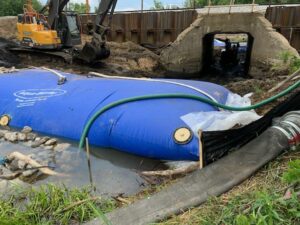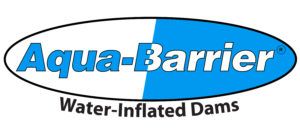In this blog post, we’ll discuss the basics of dewatering for culvert repairs, including why it’s necessary, how it’s done, and what to consider when planning your project.
Why is Dewatering on Culvert Repairs Important?
Effective dewatering is an essential process for many construction projects, including culvert repairs. Dewatering is often necessary for construction projects that involve excavation, as it allows crews to safely access the work area. In the case of culvert repairs, dewatering is especially important due to the potential for flooding by removing water from the repair area, dewatering also reduces the risk of water entering the worksite and allows crews to work safely and efficiently. Dewatering is essential for repair crews because water can interfere with the repair materials and cause the repairs to be less effective. In addition, water can also cause several safety hazards for the repair crew. There are a few different ways to execute dewatering, but the most common method is to use a sump pump. A sump pump is a device that pumps water out of an area so that it can be discharged elsewhere. Sump pumps are typically used to remove water that has accumulated in a sump pit, but they can also be used for other applications like dewatering a repair site. Another method of dewatering is to use a well point system. A well point system consists of a network of small-diameter pipes that are inserted into the ground at various points around the repair site. The pipes are then connected to a vacuum pump, which sucks the water out of the ground and into the piping system. However, the most effective dewatering method in high-risk environments is found with the use of cofferdams like the Aqua-Barrier®. The end goal for any dewatering project though is to provide a safe and dry work environment for the repair or construction crews to complete their work as quickly as possible.


Dewatering Explained
Dewatering can be accomplished through a variety of methods, including pumps, wells, evaporation, irrigation, and cofferdams as explained in more detail below. The most appropriate method will depend on a few factors, including the location of the repair site, the amount of water that needs to be removed, and the schedule for repairs. However, for most culvert repairs, however, due to the amount of water needing to be removed, the Aqua-Barrier® water inflated cofferdam is the dewatering method of choice.
Pumping
- One of the most common methods of dewatering is pumping. This involves using a pump to remove water from the culvert and discharge it into an appropriate location. When selecting a pump for this purpose, it is important to consider the flow rate, head height, and power source. For most culvert repair or construction projects, this process can take anywhere from several hours to days or more.
Wellpoints
- Another common method of dewatering is using wellpoints. This involves installing small pipes (wellpoints) into the ground around the perimeter of the culvert. A pump is then used to draw water out of the wellpoints and discharge it into an appropriate location. The advantage of this method is that it can be used to draw water from a large area at once, which helps keep construction or repair projects on schedule.
Sucking
- A third method of dewatering is sucking. This involves placing a suction hose into the water inside the culvert and using a pump to draw the water out through the hose. The advantage of this method is that it can be used to remove water from difficult-to-reach areas. Again, this is a very time intensive process that can add more manpower and expense in the long term and drive costs higher in some cases.
Cofferdams
- With cofferdams, worksites can be dried out and dammed off temporarily much faster than the alternative methods. There are several different types of cofferdams, the Aqua-Barrier® water-inflated dam being one of them. By being able to inflate the barriers with the water onsite, you save a tremendous amount of time and money on the installation – compared to sandbags and sheet piling. Offering different heights and lengths as well as the option to rent or purchase, the use of Aqua-Barrier cofferdams is the most cost-effective option for dewatering and temporary damming in general.


What Should I Consider When Planning My Project?
There are a few things to consider when planning a project that involves dewatering. First, you’ll need to obtain any necessary permits from local authorities. Next, you’ll need to develop a dewatering plan that includes an estimation of the amount of water that needs to be removed and the equipment that will be used. Finally, you’ll need to budget for the cost of dewatering services and equipment rental. When budgeting your costs, be sure not to underestimate labor hours for your crews as this is one of the most underbid areas in any project when dealing with water. The right choice in dewatering equipment can lower some of that cost, however, it’s always better to account for it than not.


Dewatering is an essential process for many construction projects, including culvert repairs. By removing water from the repair area, dewatering allows crews to access the culvert safely and effectively for repairs. In this blog post, we’ve discussed the basics of dewatering for culvert repairs, including why it’s necessary, how it’s done, and what to consider when planning your project. If you’re planning a culvert repair project that requires dewatering, contact Aqua-Barrier® today. With over 25 years of experience, our friendly and knowledgeable sales team has decades of projects under their belt and can help you select the right cofferdam for any of your upcoming projects. If your project is located outside of the U.S., that’s no problem, we have a great team of distributors that can help you as well with your dewatering needs worldwide. If you happen to be in the area and would like to visit us, we’re located in Waller, TX and we’d love for you to stop by and meet our team, or visit us online and by phone 800-245-0199.


